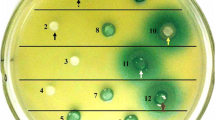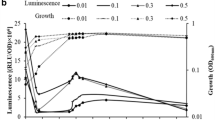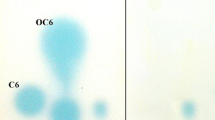Abstract
A chemically defined medium called KGm medium was used to isolate from a sample of sea water a bacterial strain, MW3A, capable of using N-3-oxohexanoyl-l-homoserine lactone as the sole carbon source. MW3A was clustered closely to Pseudomonas aeruginosa by 16S ribosomal DNA sequence analysis. It degraded both N-acylhomoserine lactones (AHLs) with a 3-oxo group substitution and, less preferably, AHLs with unsubstituted groups at C3 position in the acyl side chain, as determined by Rapid Resolution Liquid Chromatography. Its quiP and pvdQ homologue gene sequences showed high similarities to those of known acylases. Spent supernatant of MW3A harvested at 8-h post inoculation was shown to contain long-chain AHLs when assayed with the biosensor Escherichia coli [pSB1075], and specifically N-dodecanoyl-l-homoserine lactone and N-3-oxotetradecanoyl-l-homoserine lactone by high resolution mass spectrometry. Hence, we report here a novel marine P. aeruginosa strain MW3A possessing both quorum-quenching and quorum-sensing properties.








Similar content being viewed by others
References
Bainton NJ, Stead P, Chhabra SR, Bycroft BW, Salmond GPC, Stewart GSAB, Williams P (1992) N-(3-oxohexanoyl)-l-homoserine lactone regulates carbapenem antibiotic production in Erwinia carotovora. Biochem J 288:99–1004
Chan KG, Tiew SZ, Ng CC (2007) Rapid isolation method of soil bacilli and screening of their quorum-quenching activity. Asia Pac J Mol Biol Biotechnol 15:153–156
Chan KG, Yin WF, Sam CK, Koh CL (2009) A novel medium for the isolation of N-acylhomoserine lactone-degrading bacteria. J Ind Microbiol Biotechnol 36:247–251
Chan KG, Wong CS, Yin WF, Sam CK, Koh CL (2010) Rapid degradation of N-3-oxo-acylhomoserine lactones by a Bacillus cereus isolate from Malaysian rainforest soil. Antonie van Leeuwenhoek 98:299–305
Chan KG, Atkinson S, Mathee K, Sam CK, Chhabra SR, Cámara M, Koh CL, Williams P (2011a) Characterization of N-acylhomoserine lactone-degrading bacteria associated with the Zingiber officinale (ginger) rhizosphere: co-existence of quorum-quenching and quorum-sensing in Acinetobacter and Burkholderia. BMC Microbiol 11:51
Chan KG, Puthucheary SD, Chan XY, Yin WF, Wong CS, See Too WS, Chua KH (2011b) Quorum-sensing in Aeromonas species isolated from patients in Malaysia. Curr Microbiol 62:167–172
Chhabra SR, Stead P, Bainton NJ, Salmond GPC, Stewart GSAB, Williams P, Bycroft BW (1993) Autoregulation of carbapenem biosynthesis in Erwinia carotovora by analogues of N-(3-oxohexanoyl)-l-homoserine lactone. J Antibiot 46:441–454
Chhabra SR, Philipp B, Eberl L, Givskov M, Williams P, Camara M (2005) Extracellular communication in bacteria. Top Curr Chem 240:279–315
Cicirelli EM, Williamson H, Tait K, Fuqua C (2008) Acylated homoserine lactone signaling in marine bacterial systems. In: Winans SC, Bassler BL (eds) Chemical communication among bacteria. ASM Press, Washington DC, pp 251–272
Dunny GM, Winans SC (eds) (1999) Cell-cell signaling in bacteria. American Society of Microbiology Press, Washington DC
Eberhard A (1972) Inhibition and activation of bacterial luciferase synthesis. J Bacteriol 109:1101–1105
Fuqua WC, Winans SC, Greenberg EP (1996) Census and consensus in bacterial ecosystems: the LuxR–LuxI family of quorum-sensing transcriptional regulators. Annu Rev Microbiol 50:727–751
Fuqua C, Parsek MR, Greenberg EP (2001) Regulation of gene expression by cell-to-cell communication: acyl-homoserine lactone quorum-sensing. Annu Rev Microbiol 35:439–468
Gram L, Grossart HP, Schlingloff A, Kiorboe T (2002) Possible quorum-sensing in marine snow bacteria: production of acylated homoserine lactones by Roseobacter strains isolated from marine snow. Appl Environ Microbiol 68:4111–4116
Hardman AM, Stewart GSAB, Williams P (1998) Quorum-sensing and the cell–cell communication dependent regulation of gene expression in pathogenic and non-pathogenic bacteria. Antonie van Leeuwenhoek 74:199–210
Hentzer M, Givskov M (2003) Pharmacological inhibition of quorum-sensing for the treatment of chronic bacterial infections. J Clin Invest 112:1300–1307
Huang JJ, Han JI, Zhang LH, Leadbetter JR (2003) Utilization of acyl-homoserine lactone quorum-signals for growth by a soil pseudomonad and Pseudomonas aeruginosa PAO1. Appl Environ Microbiol 69:5941–5949
Huang JJ, Petersen A, Whiteley M, Leadbetter JR (2006) Identification of QuiP, the product of gene PA1032, as the second acyl-homoserine lactone acylase of Pseudomonas aeruginosa PAO1. Appl Environ Microbiol 72:1190–1197
Krick A, Kehraus S, Eberl L, Riedel K, Anke H, Kaesler I, Graeber I, Szewzyk U, König GM (2007) A marine Mesorhizobium sp. produces structurally novel long-chain N-acyl-l-homoserine lactones. Appl Environ Microbiol 73:3587–3594
Latifi A, Foglino M, Tanaka K, Williams P, Lazdunski A (1996) A hierarchical quorum-sensing cascade in Pseudomonas aeruginosa links the transcriptional activators LasR and RhIR (VsmR) to expression of the stationary-phase sigma factor RpoS. Mol Microbiol 21:1137–1146
MacLeod RA (1965) The question of the existence of specific marine bacteria. Microbiol Mol Biol Rev 29:9–23
Miller MB, Bassler BL (2001) Quorum-sensing in bacteria. Annu Rev Microbiol 55:165–199
Mohamed NM, Cicirelli EM, Kan J, Chen F, Fuqua C, Hill RT (2008) Diversity and quorum-sensing signal production of Proteobacteria associated with marine sponges. Environ Microbiol 10:75–86
Ortori CA, Atkinson S, Chhabra SR, Camara M, Williams P, Barret DA (2007) Comprehensive profiling of N-acylhomoserine lactones produced by Yersinia pseudotuberculosis using liquid chromatography coupled to hybrid quadrupole-linear ion trap mass spectrometry. Anal Bioanal Chem 387:497–511
Pesci EC, Milbank JBJ, Pearson JP, McKnight S, Kende AS, Greenberg EP, Iglewski BH (1999) Quinolone signaling in the cell-to-cell communication system of Pseudomonas aeruginosa. Proc Natl Acad Sci USA 96:11229–11234
Puskas A, Greenberg EP, Kaplan S, Schaefer AL (1997) A quorum-sensing system in the free-living photosynthetic bacterium Rhodobacter sphaeroides. J Bacteriol 179:7530–7537
Romero M, Martin-Cuadrado AB, Roca-Rivada A, Cabello AM, Otero A (2011) Quorum-quenching in cultivable bacteria from dense marine coastal microbial communities. FEMS Microbiol Ecol 75:205–217
Rumbaugha KP, Griswold JA, Hamood AN (2000) The role of quorum-sensing in the in vivo virulence of Pseudomonas aeruginosa. Microbes Infect 2:1721–1731
Salmond GPC, Bycroft BW, Stewart GSAB, Williams P (1995) The bacterial enigma: cracking the code of cell–cell communication. Mol Microbiol 16:615–624
Sambrook JF, Fritsch EF, Maniatis T (1989) Molecular cloning: a laboratory manual. Cold Spring Harbor Laboratory Press, Cold Spring Harbor
Schauder S, Bassler BL (2001) The languages of bacteria. Genes Dev 15:1468–1480
Schuster M, Greenberg PE (2006) A network of networks: quorum-sensing gene regulation in Pseudomonas aeruginosa. Int J Med Microbiol 296:73–81
Sio CF, Otten LG, Cool RH, Diggle SP, Braun PG, Bos R, Daykin M, Càmara M, Williams P, Quax WJ (2006) Quorum-quenching by an N-acyl-homoserine lactone acylase from Pseudomonas aeruginosa PAO1. Infect Immun 74:1673–1682
Swift S, Karlyshev AV, Fish L, Durant EL, Winson MK, Chhabra SR, Williams P, Macintyre S, Stewart GS (1996) Quorum-sensing in Aeromonas hydrophila and Aeromonas salmonicida: identification of the LuxRI homologs AhyRI and AsaRI and their cognate N-acylhomoserine lactone signal molecules. J Bacteriol 179:5271–5281
Tamura K, Dudley J, Nei M, Kumar S (2007) MEGA4: molecular evolutionary genetics analysis (MEGA) software version 4.0. Mol Biol Evol 24:1596–1599
Wagner-Döbler I, Thiel V, Eberl L, Allgaier M, Bodor A, Meyer S, Ebner S, Hennig A, Pukall R, Schulz S (2005) Discovery of complex mixtures of novel long-chain quorum-sensing signals in free-living and host-associated marine Alphaproteobacteria. Chembiochem 6:2195–2206
Williams P, Winzer K, Chan W, Camara M (2007) Look who’s talking: communication and quorum-sensing in the bacterial world. Philos Trans R Soc Lond B Biol Sci 362:1119–1134
Winson MK, Camara M, Latifi A, Foglino M, Chhabra SR, Daykin M, Bally M, Chapon V, Salmond GP, Bycroft BW, Lazdunski A, Stewart GS, Williams P (1995) Multiple N-acyl-l-homoserine lactone signal molecules regulate production of virulence determinants and secondary metabolites in Pseudomonas aeruginosa. Proc Natl Acad Sci USA 92:9427–9431
Winson MK, Swift S, Fish L, Throup JP, Jorgensen F, Chhabra SR, Bycroft BW, Williams P, Stewart GSAB (1998) Construction and analysis of luxCDABE-based plasmid sensors for investigating N-acylhomoserine lactone-mediated quorum-sensing. FEMS Microbiol Lett 163:185–192
Yates EA, Philipp B, Buckley C, Atkinson S, Chhabra SR, Sockett RE, Goldner M, Dessaux Y, Camara M, Smith H, Williams P (2002) N-acylhomoserine lactones undergo lactonolysis in a pH-, temperature-, and acyl chain length-dependent manner during growth of Yersinia pseudotuberculosis and Pseudomonas aeruginosa. Infect Immun 70:5635–5646
Acknowledgments
This work was supported by a High Impact Research Grant (J-00000-73552) and the Malaysia Ministry of Science, Technology and Innovation under the Science Fund (12-02-03-2085) to KG Chan and a Postgraduate Research Grant (PS256/2008A) to CS Wong from the University of Malaya.
Author information
Authors and Affiliations
Corresponding author
Rights and permissions
About this article
Cite this article
Wong, CS., Yin, WF., Choo, YM. et al. Coexistence of quorum-quenching and quorum-sensing in tropical marine Pseudomonas aeruginosa strain MW3A. World J Microbiol Biotechnol 28, 453–461 (2012). https://doi.org/10.1007/s11274-011-0836-x
Received:
Accepted:
Published:
Issue Date:
DOI: https://doi.org/10.1007/s11274-011-0836-x




